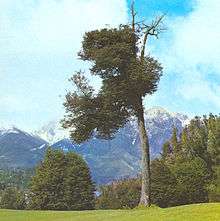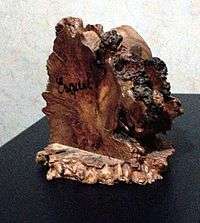Nothofagus dombeyi
| Nothofagus dombeyi | |
|---|---|
 | |
| Scientific classification | |
| Kingdom: | Plantae |
| (unranked): | Angiosperms |
| (unranked): | Eudicots |
| (unranked): | Rosids |
| Order: | Fagales |
| Family: | Nothofagaceae |
| Genus: | Nothofagus |
| Species: | N. dombeyi |
| Binomial name | |
| Nothofagus dombeyi Mirb. Oerst. | |
| Synonyms | |
|
Fagus dombeyi | |

Nothofagus dombeyi (Dombey's beech,[1] coigue,[2] coihue or coigüe (from koywe in Mapuche language)) is a tree species native to southern Chile and the Andean parts of Argentine Patagonia. It grows from 35 to 45° South latitude between 700 and 1,200 m (2,300 and 3,900 ft) above mean sea level. It forms dense forests, like those found in the Los Alerces and Nahuel Huapi national parks. It thrives in low hills with gentle slopes, being very demanding of water and soil; the largest forests are found on the slopes looking south, and the healthier specimens tend to grow on the banks of rivers and lakes. It sometimes forms mixed forests with Araucaria araucana (monkey-puzzle) trees, for example in the Villarrica National Park in Chile. It is fast-growing and well-distributed species that lives in several climatic conditions.
.jpg)
It can become a large tree, up to 45 m (148 ft) high and 1.9 m (6.2 ft) in diameter. One tree, felled by a storm in 1954, reportedly measured 2.55 m (8.4 ft)in diameter at the height of a man's chest and a total volume, including the branches, of 87 m³.
The coihue usually has elegant branches which are flattened horizontally. The leaves are evergreen, small (25–40 mm long and 10–16 mm wide), thick, coriaceous and lustrous, dark green, with toothed borders and an acute apex; they have a very small, rounded and rhomb-shaped petiole. The tree is hermaphroditic; male and female flowers are grouped in the same tree, and pollen is spread by wind action. The flowers are little visible because they are green and measure less than 5 mm. The fruit is a triangular nut that measures about 4–7 mm.
Coihue timber is considered excellent. In Argentina its exploitation is limited by the presence of the best forests within national parks. The wood is bright grayish white; the heartwood is a pale pink-white, which darkens after cut. Its texture is very fine and makes it easy to work with. It has a beautiful engraving, is semi-heavy, hard, durable, easy-to-work and decay resistant. It is used in furniture, barrels, floors and building. It has been introduced as ornamental in the British Isles[3] and also in the North Pacific Coast of the United States.[4]
The name of the tree is often spelled coigüe (reflecting the common pronunciation with an epenthetic g). Other related trees named coihue are the Coihue de Magallanes (Nothofagus betuloides), and the Coihue de Chiloé (Nothofagus nitida).
References
- ↑ "BSBI List 2007". Botanical Society of Britain and Ireland. Archived from the original (xls) on 2015-02-25. Retrieved 2014-10-17.
- ↑ "Nothofagus dombeyi". Natural Resources Conservation Service PLANTS Database. USDA. Retrieved 29 January 2016.
- ↑ TWFS List of Accepted Plants of the British Isles 2007
- ↑ "Nothofagus dombeyi in Washington Park Arboretum" (PDF).
Further reading
- Libro del Árbol: Especies Forestales Indígenas de la Argentina de Aplicación Industrial (edited by Celulosa Argentina S. A., Buenos Aires, October 1975)
- Donoso, C. 2005. Árboles nativos de Chile. Guía de reconocimiento. Edición 4. Marisa Cuneo Ediciones, Valdivia, Chile. 136p.
- Hoffmann, Adriana. 1998. Flora Silvestre de Chile, Zona Central. Edición 4. Fundación Claudio Gay, Santiago. 254p.
- Rodríguez, R. & Quezada, M. 2003. Fagaceae. En C. Marticorena y R. Rodríguez [eds.], Flora de Chile Vol. 2(2), pp 64–76. Universidad de Concepción, Concepción.
External links
- González (1998). "Nothofagus dombeyi". IUCN Red List of Threatened Species. Version 2006. International Union for Conservation of Nature. Retrieved 12 May 2006.
- "Nothofagus dombeyi" in Encyclopedia of Chilean Flora (in Spanish)
- Nothofagus dombeyi in Chilebosque (in Spanish)
- Nothofagus dombeyi, description and images from ChileFlora (in English)
- Nothofagus dombeyi in Scotland
- Nothofagus, les hêtres du bout du monde... (in French)
| Wikimedia Commons has media related to Nothofagus dombeyi. |
